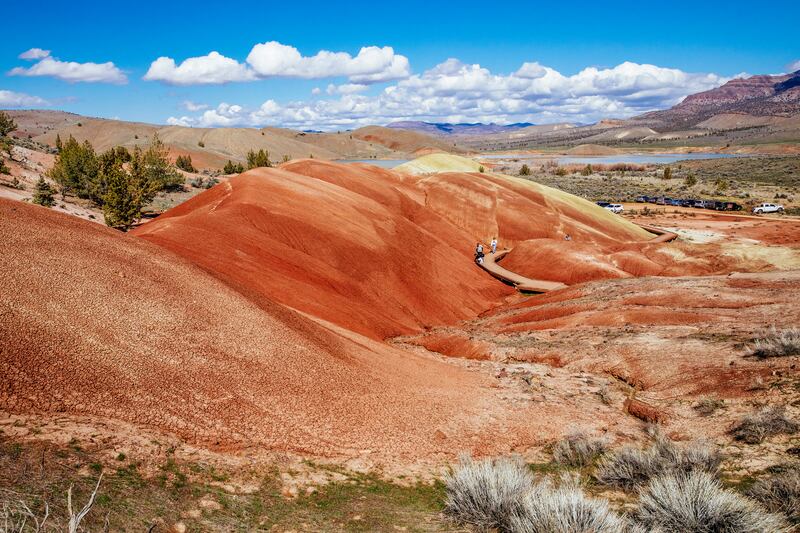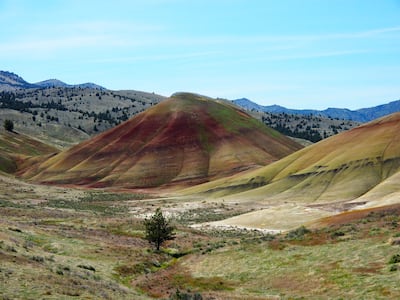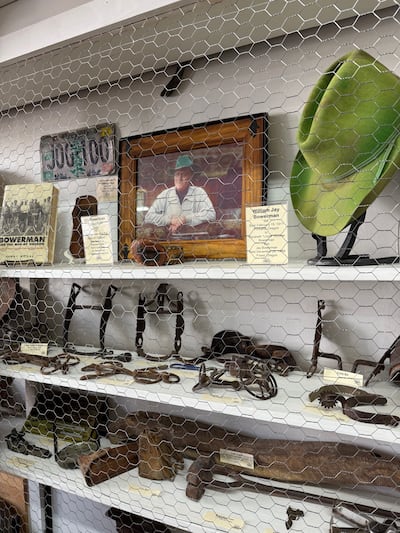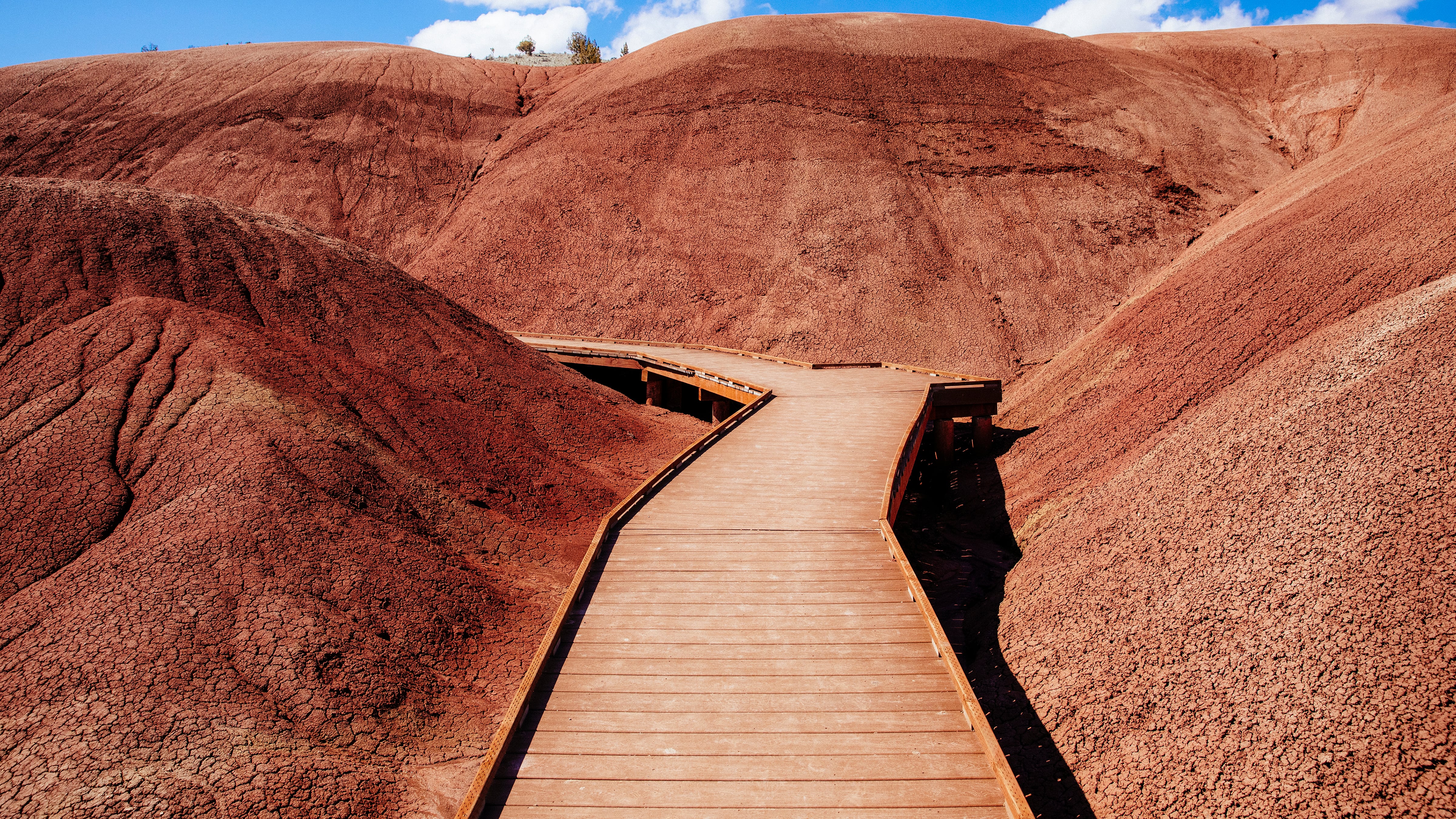The typical way to think about climate change is that it’s evidence of human beings’ hedonism and recklessness. We spew our chemicals, gases and garbage wherever we please, and the earth heats, cracks and suffers.
But you can also look at what’s happening to the environment as Mother Nature fighting back. We humans may need fertile soil, clean water, and fresh air to survive, but she doesn’t. The landscape can and does adapt to nearly any disaster—no matter what the cost to the creatures who depend on a hospitable atmosphere to thrive.
Whether you find that notion distressing or comforting, you’ll find inspiration and wonder in Oregon’s High Desert. It’s a trip that should be on every Oregonian’s bucket list.
John Day Fossil Beds National Monument (nps.gov/joda) is a bafflingly underexplored marvel of the state’s landscape. Only about three hours away from Portland, a visit offers the sublime experience of descending into a prehistoric world or faraway planet.
This geological marvel formed over millions of years of active volcanoes cycling through epic booms and devastating bursts, flooding the better part of Oregon and Southern Washington with countless acres of lava. The rich fossil record still being uncovered stands as a testament to the immortal words of Jeff Goldblum via Michael Crichton: “Life finds a way.”
There are three sections to the national monument, which in total encompasses more than 14,000 acres. Together they highlight some of the most valuable fossil grounds within the entire John Day Fossil Beds, which blanket most of Eastern Oregon. Fun fact: More than 20% of Oregon is considered a fossil bed.
Be aware: You won’t find remnants of a T. rex or velociraptor; this area was underwater during the dinosaur periods. Instead, national parks scientists have so far cataloged more than 45,000 fossils representing 2,000 species revealing the marvelously bizarre and lesser-known creatures from the Age of Mammals. Together, this fossil record represents the period from 44 million years ago until 7 million years ago. It’s an impossibly vast amount of time to imagine, but readily puts our own 100-year lifespan (at best) into glaring perspective.

The Thomas Condon Visitor Center anchors the Sheep Rock Unit and is a fine place to start your explorations. A helpful short film plays every half hour and depicts the apocalyptic power that shaped this stunning landscape.
Scientists explain the value of studying the ancient past to inform the present and future. In the visitor center, exceedingly well-informed and helpful staff quietly bemoan the impacts of DOGE cutbacks. But at present, you can watch paleontologists behind a glass wall carefully chip away at some of the plant and animal fossils unearthed nearby.
The exhibits emphasize mammals over rocks—you may be surprised to learn that this part of Oregon had creatures like camels, elephants and rhinoceroses before earlier climate and population upheavals sent them into extinction, at least on this continent. One type of four-tusked elephant seems especially ripe for a Disney reboot. Called Gomphotherium, they migrated here over a land bridge from Asia around 15 million years ago. Another animal that could make a special stuffy is the Zygolophodon, a type of mastodon that weighed up to 10 tons. Cleverly, the exhibits use a selection of recorded (and imagined) sounds to send visitors into the multidimensional experience of living around these great beasts.
Outside the visitor center are several well-marked hikes. One of the most popular, the Blue Basin Overlook Trail, is temporarily closed due to mudslides; staff isn’t sure when the trail can be fixed and reopen thanks to current government turmoil.
In the meantime, the shorter but still spectacular Island in Time hike (1.3 miles round trip) takes you along eerie blue-tinged hills, the results of compacted ash. Rocks here date from 95 million years old.
While it’s a journey to get to the John Day Fossil Beds, the units themselves have uncommonly accessible trails. Some of the most stunning, including Flood of Fire and Story in Stone, which begin at the Foree Trailhead, are less than a half-mile each. Leashed pets are welcome throughout the park.
The Clarno Unit offers the best trail in the monument to view real fossils in the wild. The accurately named Trail of Fossils reveals leaf imprints within the boulders. The animal record here reveals dog-sized horses, huge rhinolike brontotheres, types of crocodiles, and other early carnivores like the creodonts that roamed what was once a lush jungle abundant with plant and animal life.
The peaceful Painted Hills Unit is breathtaking, and not only because there’s little shade and steep hills to climb. You’ll see vast mounds striped with shades of a sunrise, glowing red and gold. The darker strips indicate periods of a wetter landscape when rainfall would hit more than four feet per year. The lighter shades show what happens in a drier climate—annual rainfall today averages just 12 inches. These painted hills look barren, and the air is hushed until you walk through, up and over them along the nicely maintained walkways. The sky comes alive with birdsong, and you may notice tiny branches fighting their way through the rocks.

They say survival is for the fittest, but here it feels like survival is for the determined. If Mother Nature can fight to live another day, who knows what we can do?
KNOW BEFORE YOU GO
Some of the roads out here are narrow, winding, and gravel, and cell service is spotty. Bring a paper map or download directions before you go. Leave with a full tank of gas or make note of charging stations if you need them. It’s going to take longer to get from one place to another than you think, so don’t try to do too much in one day.
Especially in summertime, bring water and leave early. It will be hot come afternoon. But take it slow. This is a place where the journey can be as memorable as the destination.
WHERE TO STAY
Hotel Condon
202 S Main St., Condon
hotelcondon.com
Worthy of a trip all on its own, the Hotel Condon provides a nearly magical drop back to a different time, when small towns defined American culture. The hotel, built in 1920, anchors downtown, which is determinedly fighting to stay vibrant. And it will, if current managers Jane and Joseph Cadousteau have anything to do with it.
Their story sounds like the treatment for a Netflix or Hallmark movie. The couple met, in a most unlikely story, while working at Disney World Hong Kong. Jane grew up in the Portland-Vancouver area, dreaming of becoming a ballet dancer. That drive took her to Hong Kong, where she performed in shows for the local Disney park.
Joseph grew up in Tahiti and studied economics there and in France before a Disney exec lured him to Hong Kong to show off his talents as a fire dancer. He has won four international titles (including second place in the World Fireknife Championship just last month). After a stint with Cirque du Soleil, he and Jane were looking for a more stable place to raise their growing family (they now have four children ranging in age from 2 to 11). Jane’s father grew up in Condon and worked in real estate. He knew how important it was for the town to keep the hotel going. One thing led to another and, six years ago, the young couple moved into town and took over operations.
It’s hard to imagine a bigger adjustment, but they’ve clearly thrived living in the small town. They love talking to people who come through—lots of government workers and hunters in winter, bikers and cyclists in the summer, and anyone who wants a real escape from city life without giving up creature comforts every month of the year.
Just two and a half hours from Portland, Condon feels like at least a century away. The hotel’s comfortable rooms are spacious and meticulously decorated with pieces from local artists. There’s a charming lounge on every floor packed with games and books. Breakfast is included with every stay—as is fascinating conversation. You’ll likely find Joseph behind the check-in desk when you arrive, and he’ll happily tell you about how a fire dancing economist from Tahiti finds life in rural small-town Oregon.
Last summer, the hotel added to its allure with the opening of Wild Sage restaurant. Owner Aly Sedlock, of nearby Mayville, emphasizes dishes made from scratch with quality, local ingredients.
Fun fact about Condon: Two Nobel Prize winners, William P. Murphy and Linus Pauling, went to Condon High School.
Wilson Ranch Retreat Bed and Breakfast
15809 Butte Creek Road, Fossil
wilsonranchesret-reat.com/oregon-bed-and-breakfast
Spend time on this working 9,000-acre ranch (it contributes its wares to the acclaimed Painted Hills beef label). Whether you stay in one of the six generously sized rooms or suites or camp in your own RV, after a hearty cowboy breakfast, you can head out on horseback (intrepid riders can try their hand at herding cattle), hike, fish or simply enjoy the relaxation that comes from being in a place that feels far, far away.
Spoke’n Hostel
300 US Highway 26, Mitchell
spokenhostel.org
The most remarkable element of the Spoke’n Hostel is that it operates on a pay-what-you-will system. Catering primarily to cyclists and explorers, it features a large room with a dozen handcrafted bunks with privacy curtains. Fresh linens and towels are provided, making this a comfortable spot to rest during a multiday ride. Make dinner in the communal kitchen or walk down Mitchell’s main street to find the brewpub and grocery store.
WHERE TO EAT
The Condon Local
201 S Main St., Condon
condonlocal.com
Jeremy Kirby is another unlikely business owner. He was raised in Condon but spent much of his adult life in New York City, working on the highest-end photo shoots for luxury goods. But when he heard that the Country Flowers business was closing, he decided to move back to his hometown and help keep Main Street alive. Now selling boutique clothing, jewelry, home décor, flowers, and books (it’s an official Powell’s Books location), the Condon Local is also a restaurant, ice cream parlor, and coffee shop. Definitely a place where you can meet the locals.
Two Boys’ Meat & Grocery
301 S Main St., Condon
The place to load up on car snacks and picnic supplies. This is the kind of friendly local store that can make you want to move to a small town.
Tiger Town Brewing
108 W Main St., Mitchell
tigertownbrewing.com
You don’t have to be here for long before you’ll start making friends. This sweet little microbrewery offers a surprisingly large menu of pub standards to go along with the local beers and cocktails. A charming outdoor patio and old-timey bar inside compete for most desirable seating. If you like what you drink, the friendly staff will can it for you on the spot.
Top Water Pizza Trailer and Ben’s Bar
938 Willow St., Spray
Keith Mitchell is living his dream. Over the past few decades, he built a successful tree business in the Portland area, but his heart has always belonged to the river. He loves rafting and fishing and one day spotted a parcel of land for sale at a bend in the John Day just outside the town of Spray. He leapt at the chance.
In 2023, he opened the Top Water Pizza Trailer, and it’s a delight. You don’t expect to find this quality of pizza so far from the big city scene. This summer’s addition is Ben’s Bar, which has one of the most fantastic river views you’ll ever find. Cleverly crafted from an old grain silo, Ben’s has barn doors facing the river, so patrons can take in the John Day rushing by. Mitchell opened in April and plans to be open Thursday through Sunday all summer with occasional live music.
Insider tip: The name of the bar comes from a family joke. “Where you been?” “Been drinking.”
OTHER AREA ATTRACTIONS
Rock Hunting
It’s a gift to know yourself. Alison Jean Cole (alisonjeancole.com) boldly proclaims, “My world revolves around rocks.”
Author of Beautiful Rocks and How to Find Them (Princeton Architectural Press, 2024) and A Rockhound’s Guide to Oregon & Washington (Mountaineers Books, 2025). Cole makes gorgeous jewelry from area rocks and leads camping excursions for rockhounding in the Oregon and Nevada deserts. Sign up for her mailing list to learn more. She’s also open to private tours.
Fossil Hunting and Local History
Fossil Museum
501 1st St., Fossil
fossilmuseum.org
Stop off in Fossil to explore the jam-packed and meticulously organized Fossil Museum. Thousands of artifacts reveal the stories of the people who’ve lived in the area, focusing on the last hundred years. You can get lost in a living history lesson exploring treasures like Grace Line’s midwife box (containing mutton fat, root beer extract, turpentine and angostura bitters), Bill Bowerman’s license plate (JOG 100) and his acid green hat (the Nike co-founder lived out the end of his life in Fossil), an homage to the varying types of barbed wire that “fenced the West,” and all kinds of artifacts from Kinzua, a company town established to support the Kinzua Pine Mills Company. It operated from 1927 to 1978, when the mill closed and the town was demolished.
You can also climb the gentle hill behind Wheeler High School’s athletic field (404 Main St.) and dig for your own fossils.

COOL OFF
It’s hot in the desert in the summer. But there are plenty of fantastic places to cool off.
Cottonwood Canyon State Park
gilliamcountyor.gov/recreation/cottonwood_canyon/index.php
The John Day River cuts through this stunning state park. There are a variety of camping options and plenty of space to drop in for a dip in the swimming hole. The park temporarily closed recently due to the Rowena fire, so check the website before you head out.
Big Bend Recreation Site
blm.gov/visit/big-bend-campground-central-oregon
Located near Kimberly at, no surprise, a big bend in the John Day River. The water here makes a fantastic swimming hole. There are also four campsites on the northern bank of the river.
Priest Hole
blm.gov/visit/priest-hole-recreation-site
This special spot is in one of those places whose devotees beg you not to put it in the paper. Located on the John Day River about 12 miles from Mitchell, it’s a trek to get here, but you’ll be glad you did. There are 14 walk-in campsites and a day use area.
This story is part of Oregon Summer Magazine, Willamette Week’s annual guide to the summer months, this year focused on making the most of and beating the heat. It is free and can be found all over Portland beginning Sunday, June 29, 2025. Find a copy at one of the locations noted on this map before they all get picked up! Read more from Oregon Summer magazine online here.
 Opens in new window
Opens in new window
